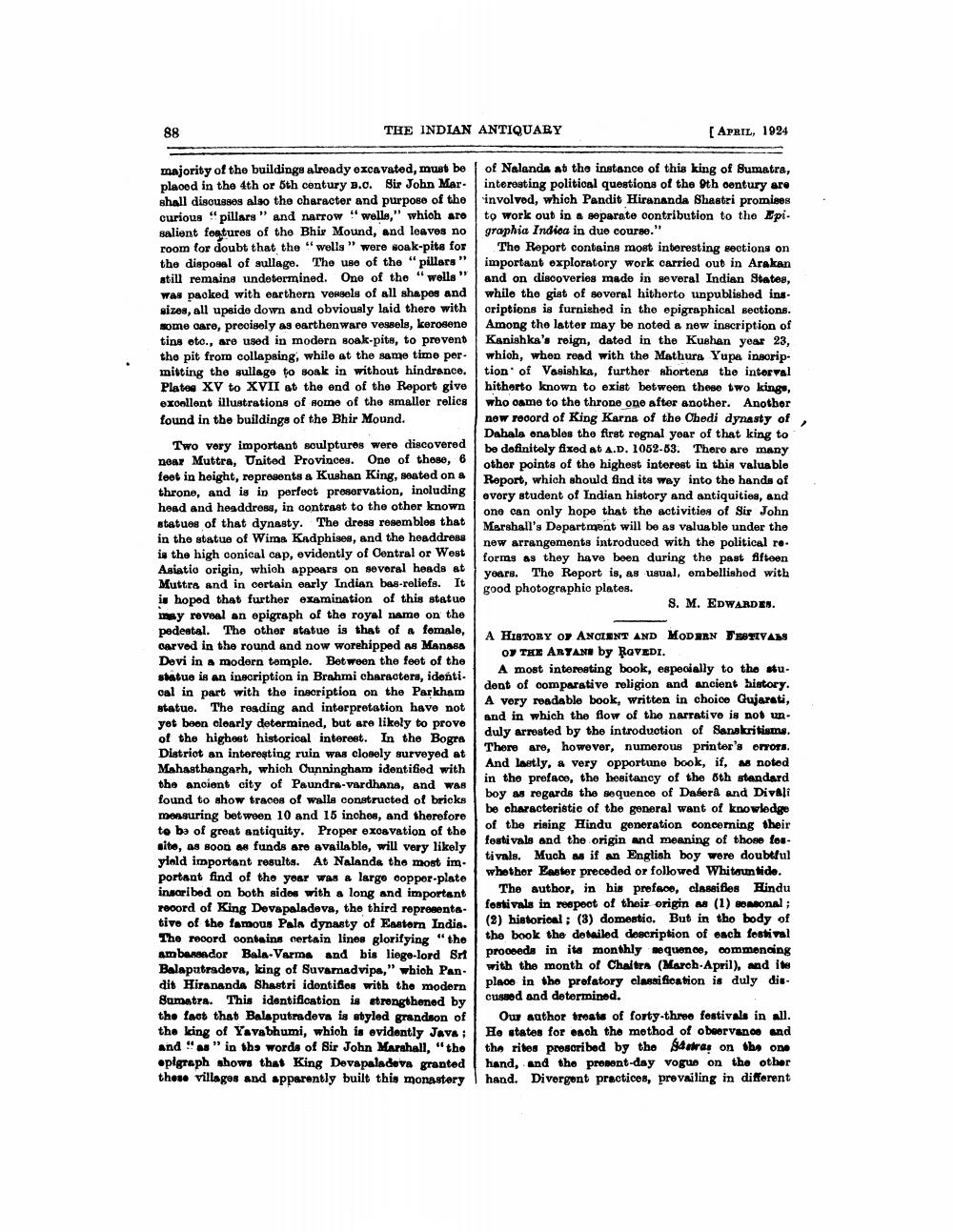________________
88
THE INDIAN ANTIQUARY
majority of the buildings already excavated, must be placed in the 4th or 5th century B.C. Sir John Marshall discusses also the character and purpose of the curious "pillars" and narrow "wells," which are salient features of the Bhir Mound, and leaves no room for doubt that the "wells" were soak-pits for the disposal of sullage. The use of the "pillars" still remains undetermined. One of the "wells" was packed with earthern vessels of all shapes and sizes, all upside down and obviously laid there with some care, precisely as earthenware vessels, kerosene tins etc., are used in modern soak-pits, to prevent the pit from collapsing, while at the same time permitting the sullage to soak in without hindrance. Plates XV to XVII at the end of the Report give excellent illustrations of some of the smaller relics found in the buildings of the Bhir Mound.
Two very important sculptures were discovered near Muttra, United Provinces. One of these, 6 feet in height, represents a Kushan King, seated on a throne, and is in perfect preservation, including head and headdress, in contrast to the other known statues of that dynasty. The dress resembles that in the statue of Wima Kadphises, and the headdress is the high conical cap, evidently of Central or West Asiatic origin, which appears on several heads at Muttra and in certain early Indian bas-reliefs. It is hoped that further examination of this statue may reveal an epigraph of the royal name on the pedestal. The other statue is that of a female, carved in the round and now worshipped as Manasa Devi in a modern temple. Between the feet of the statue is an inscription in Brahmi characters, identi cal in part with the inscription on the Parkham statue. The reading and interpretation have not yet been clearly determined, but are likely to prove of the highest historical interest. In the Bogra District an interesting ruin was closely surveyed at Mahasthangarh, which Cunningham identified with the ancient city of Paundra-vardhana, and was found to show traces of walls constructed of bricks measuring between 10 and 15 inches, and therefore to be of great antiquity. Proper excavation of the site, as soon as funds are available, will very likely yield important results. At Nalanda the most important find of the year was a large copper-plate inscribed on both sides with a long and important record of King Devapaladeva, the third representative of the famous Pala dynasty of Eastern India. The record contains certain lines glorifying "the ambassador Bala-Varma and bis liege-lord Sri Balaputradeva, king of Suvarnadvipa," which Pandit Hirananda Shastri identifies with the modern Sumatra. This identification is strengthened by the fact that Balaputradeva is styled grandson of the king of Yavabhumi, which is evidently Java: and "as" in the words of Sir John Marshall, "the epigraph shows that King Devapaladeva granted these villages and apparently built this monastery
[APRIL, 1924
of Nalanda at the instance of this king of Sumatra, interesting political questions of the 9th century are involved, which Pandit Hirananda Shastri promises to work out in a separate contribution to the Epi. graphia Indica in due course."
The Report contains most interesting sections on important exploratory work carried out in Arakan and on discoveries made in several Indian States, while the gist of several hitherto unpublished inscriptions is furnished in the epigraphical sections. Among the latter may be noted a new inscription of Kanishka's reign, dated in the Kushan year 23, which, when read with the Mathura Yupa inscription of Vasishka, further shortens the interval hitherto known to exist between these two kings, who came to the throne one after another. Another new record of King Karna of the Chedi dynasty of, Dahala enables the first regnal year of that king to be definitely fixed at A.D. 1052-53. There are many other points of the highest interest in this valuable Report, which should find its way into the hands of every student of Indian history and antiquities, and one can only hope that the activities of Sir John Marshall's Department will be as valuable under the new arrangements introduced with the political re forms as they have been during the past fifteen years. The Report is, as usual, embellished with good photographic plates.
8. M. EDWARDES.
A HISTORY OF ANCIENT AND MODERN FESTIVALS OF THE ARYANE by RGVEDI.
A most interesting book, especially to the student of comparative religion and ancient history. A very readable book, written in choice Gujarati, and in which the flow of the narrative is not unduly arrested by the introduction of Sanskritisms. There are, however, numerous printer's errors. And lastly, a very opportune book, if, as noted in the preface, the hesitancy of the 5th standard boy as regards the sequence of Daserâ and Divali be characteristic of the general want of knowledge of the rising Hindu generation concerning their festivals and the origin and meaning of those festivals. Much as if an English boy were doubtful whether Easter preceded or followed Whiteuntide.
The author, in his preface, classifies Hindu festivals in respect of their origin as (1) seasonal; (2) historical; (3) domestic. But in the body of the book the detailed description of each festival proceeds in its monthly sequence, commencing with the month of Chaitra (March-April), and its place in the prefatory classification is duly discussed and determined.
Our author treats of forty-three festivals in all. He states for each the method of observance and the rites prescribed by the Satras on the one hand, and the present-day vogue on the other hand. Divergent practices, prevailing in different




